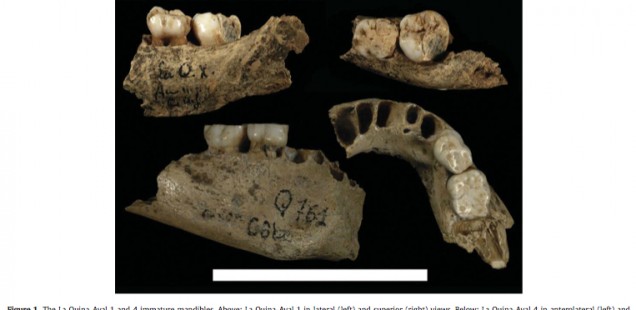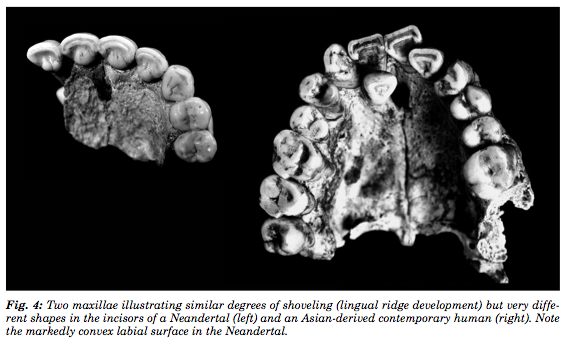
Early Aurignacian Dentition and Why Paleontology Is a Moving Target
Journal of Human Evolution (In Press, Corrected Proof)
The Early Aurignacian human remains from La Quina-Aval (France)
Christine Verna, Véronique Dujardin, and Erik Trinkaus.
There is a dearth of diagnostic human remains securely associated with the Early Aurignacian of western Europe, despite the presence of similarly aged early modern human remains from further east. One small and fragmentary sample of such remains consists of the two partial immature mandibles plus teeth from the Early Aurignacian of La Quina-Aval, Charente, France. The La Quina-Aval 4 mandible exhibits a prominent anterior symphyseal tuber symphyseos on a vertical symphysis and a narrow anterior dental arcade, both features of early modern humans. The dental remains from La Quina-Aval 1 to 4 (a dm1, 2 dm2, a P4 and a P4) are unexceptional in size and present occlusal configurations that combine early modern human features with a few retained ancestral ones. Securely dated to ∼33 ka 14C BP (∼38 ka cal BP), these remains serve to confirm the association of early modern humans with the Early Aurignacian in western Europe.
Link (Article for Purchase Only)
Very few people realize that up until now we haven’t had a definitive proof that Early Aurignacian was made by modern humans (and not by Neanderthals or a unknown hominid species). This odontological paper, plus another recent one, argues that this direct proof is finally available. There is no surprise here and due to the very nature of the archaeological profile of Aurignacian (blade-based Mode 4 toolkit vs. Neanderthal’s flakes-based Mousterian, or Mode 3 toolkit, etc.) it’s been clear for a very long time that Aurignacian was made by modern humans.
The importance of this paper is not so much is finding the definitive proof that Early Aurignacian was made by modern humans, but in the timing of this discovery. It took paleontology more than a hundred years to come up with modern human remains associated with a certain toolmaking culture. And these remains are two partial mandibles plus a few teeth. This is contrasted with dozens of Neandertal skulls recovered so far in Europe and a healthy bunch of Neanderthal DNA samples from all over Eurasia. And one would expect more populous and recent Aurignacian humans to have left plenty of fossils behind. But the reality of fossil recovery is not that linear.
The time that it takes to recover critical pieces of paleontological evidence for modern human origins and dispersals is a systematic property of scientific research and part and parcel of the nature of paleontological evidence. Up until 2007 it was widely believed that modern humans didn’t get into East Asia until some 40,000 YBP. But then the discovery of a fully modern chin from Zhirendong (South China) instantly made the presence of modern humans in this part of the world older by a whopping 60,000 years. And the only evidence for the Denisova hominid, who is believed to have contributed up to 6% of the total autosomal genetic content and up to 75% of HLA genes to different modern human groups, comes from the DNA extracted, as recently as 2010, from a tooth and a pinkie found in a South Siberian cave. How many unreported and potentially revolutionary teeth and phalanges are strewn across the caveworld? One of the recent finds that falsified the Clovis-I paradigm in American archaeology was far from being a complete skeleton; instead, it was coprolites unearthed from the Paisley Cave in Oregon in 2008. Until 2005, science failed to produce any fossil remains of chimpanzees, although thousands of fossils of hominids have been recovered to date. Finally, it was only in 2003 that a new hominid species that may have survived into the early Holocene was recovered on the island of Flores (Homo floresiensis). And the discovery came with no fewer than 9 partial skeletons. If, in 2002, we asked a paleontologist how likely it was that one would discover a new miniature hominin species hunting megafauna as late as the Early Holocene, s/he would have laughed at the question.
But somehow our ideas of human origins and dispersals are shaped first and foremost by paleontological findings or lack thereof. The out-of-Africa model of human origins was originally built on the basis of a handful of partially preserved “anatomically modern human” skulls from Africa. The absence of hominid or human remains in America prior to 11,000 YBP has been a core argument in favor of an almost Holocene timeframe of human entry into the New World. Absence of evidence has always been quietly assumed to be evidence of absence. Evidence of presence, on the other hand, has been held to the unrealistic standards of sufficency, as the example of human friction skin imprints and human hair from the Pendejo Cave in North America dated at 20,000 years demonstrates.
The original expansion of modern humans out of Africa has no archaeological correlates. When mtDNA was first sequenced, the results were mechanically mapped onto the scientific paradigm derived from paleontology – the oldest fossils are in Africa, there are no fossils earlier than 11,000 YBP in the Americas, hence African high intragroup allelic diversity must indicate greater age, while the New World low intragroup allelic diversity must indicate young age. But paleontology is a moving target, and science is on a very shaky ground when it uses accidentally found, unpredictable, fragmentary, incomplete, perishable and poorly preserved fossils as a foundation for the interpretation of the systematic data that comes from modern human populations. We should remind ourselves of the methodological dictum clearly articulated by Eldridge & Gould (“Punctuated equilibria: An alternative to phyletic gradualism, ” Models in Paleobiology. San Francisco, 1972, p. 93).
“No theory of evolutionary mechanisms can be generated directly from paleontological data. Instead, theories developed by students of the modern biota generate predictions about the course of evolution in time.”
When this critical focus on the data derived from modern human populations in generating hypotheses about human origins and dispersals is missing, it’s likely that cultural stereotypes are interfering to manipulate the inherently partial paleontological data and drive a particular vision of the human past.
Going back to the paper, the La Quina-Aval teeth are poorly preserved (see below, p. 3). The state of the mandibles doesn’t allow us to clarify one important point about the dentition of the earliest modern humans in Europe: did they have shovel-shaped incisors and in what frequency?
It’s known that “there are certain [dental. – G.D.] traits for which Neandertal trait frequencies fall within the range of those of modern humans. Lingual marginal ridge development (shoveling) is one of these. Like Neandertals, certain Asian-derived groups (including North East Asians and Native Americans) present high frequencies of well-developed shovel-shaped incisors.” (Bailey, S. “The evolution of non-metric dental variation in Europe,” Mitteilungen der Gesellschaft für Urgeschichte 15 (2006), 16-17.) Shoveling in Neandertals is different from shoveling in modern humans (see below, from Bailey 2006) but it’s still remarkably similar.
Among modern humans, shoveling is very frequent among American Indians and Asians and relatively infrequent among Europeans and Africans. Modern European and African teeth tend to have chiseled incisors. Dentally, Africans and Northeast Asians/Amerindians occupy the opposite poles of variation (see, Irish, J. D. “Ancestral dental traits in recent Sub-Saharan Africans and the origins of modern humans,” Journal of Human Evolution 34 (1998): 81-98). From our current knowledge of more recent European samples, moderate development of shoveling was detected in some Gravettian samples such as Dolní Věstonice 15 (see below, from Hilson S. W. “Dental Morphology, Proportion and Attrition,” in Early Modern Evolution in Central Europe: The People of Dolní Věstonice and Pavlov. Oxford, 2006, p. 79-80).
Dental samples from Neolithic Catalhoyuk showed frequencies of shovel-shaped incisors comparable to modern West Eurasians (see below, from Pilloud M. A. Community Structure at Neolithic Çatalhöyük: Biological Distance Analysis of Household, Neighborhood, and Settlement. Ph.D. dissertation. Ohio State University, 2009, p. 774).
Assuming that pronounced and frequent shoveling was characteristic of early modern humans, do we see here a trend toward a more dramatic decline of shoveling in European vs. African samples? Does it mean that this decline has advanced at a faster rate in Europe than in Africa? How much shoveling did early Aurignacians in Europe have? So, while we now know for a fact that Aurignacian tools were made by modern humans, we don’t know if early Aurignacians were more like modern American Indians and Asians in their trait frequencies or more like modern Africans. It may take paleonthology another 100 years to come up with an answer.





